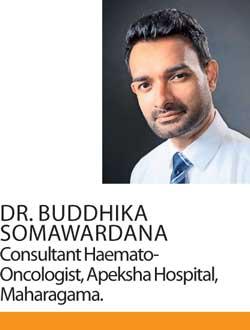18 Dec 2020 - {{hitsCtrl.values.hits}}

 Cancer is not just a zodiac sign, but a terrifying term which makes the heart race, as it can turn one’s life upside down in a spur of a second. Most of the late stage cancers are not curable, so it is always better to stay aware of early signs and symptoms and seek medical advice as soon as possible.
Cancer is not just a zodiac sign, but a terrifying term which makes the heart race, as it can turn one’s life upside down in a spur of a second. Most of the late stage cancers are not curable, so it is always better to stay aware of early signs and symptoms and seek medical advice as soon as possible.
Today we are going to discuss about Leukemia, a common blood cancer with Dr Buddhika Somawardana, Consultant Haemato-Oncologist, Apeksha Hospital, Maharagama. Bone marrow is the semisolid tissue found within the spongy portion inside bones. It is the factory where mature cellular components of blood are produced, namely red blood cells, platelets and white blood cells. They originate as immature primitive cells- stem cells which later multiply and mature in to specialised blood cells through a highly disciplined, systematic process along several pathways. This is called ‘Haematopoiesis’.
“There’s nothing in this world which cannot go wrong and haematopoiesis is not an exception. During the process of white blood cell formation, mutations can take place in the genetic material of these cells making them abnormal. This can happen at any stage of haematopoiesis. These abnormal cells gain the ability to multiply faster resulting in an abnormal clone of cells which soon invade the bone marrow crowding out normal cells, spills in to the bloodstream and infiltrate other organs of the body which is called leukaemia” doctor explains.

Based on the stage at which the abnormal mutations occur, there are two main types of leukaemia :
Acute leukaemia- Uncontrolled cell division taking place at an early stage of haematopoiesis so, the abnormal cells are immature, cannot carry out their normal functions and they multiply rapidly and the disease worsens quickly.
Chronic leukaemia takes place when this occurs at a later stage of maturation. These blood cells replicate or accumulate slowly and function normally for a period of time.There are many types of chronic leukemias where some produce too many cells and some produce less.
Risk factors
This purely depends on the type of leukaemia. While the majority of leukaemias is generally commoner in adults, some acute leukaemias are commoner among children and young adults. Although the exact etiology is unclear, pathology seems to be developing from a combination of genetic and environmental factors including,
The situation in Sri Lanka
According to statistics of National Cancer Control Programme, there are about 250 leukaemia cases reported annually and this is approximately 1.5% of the total number of newly diagnosed cancer cases.
Presentation and management
“Some forms of chronic leukaemia initially produce no early symptoms and can go unnoticed or undiagnosed for years while acute leukaemias have an aggressive course. Some of the commonest symptoms include fever or chills, persistent fatigue, frequent infections, unintentional loss of weight, swollen lymph nodes, easy bleeding or bruising, frequent nosebleeds, tiny red spots in the skin, excessive sweating, especially at night and bone pain or tenderness” Dr Somawardana highlights. You need to seek medical attention if one or more of these symptoms are persistent. The type of treatment varies from observation and simple pills to complex courses of intensive chemotherapy and stem cell transplants based on the disease type.
Treatment options and availability
“Leukaemia treatment is evolving with the influx of new data from various clinical researches globally. We have most of the basic facilities to manage almost all types of leukamias. Being in the process of developing allogeneic stem cell transplants in the state sector as a treatment for leukamias in Sri Lanka, we are 3 decades behind the rest of the world in this regard. Some new medications which target abnormal leukaemic cells are prohibitively expensive and are not available in the country,” says Dr. Somawardana.
Researches are trying to separate patient’s own immune cells and modify them genetically to attack cancer cells selectively and efficiently when re-infused into the patient.
“This treatment modality called CART therapy has been successful in some leukaemias and is still under research” Dr. Somawardana concluded.
21 Dec 2024 4 hours ago
21 Dec 2024 5 hours ago
21 Dec 2024 8 hours ago
21 Dec 2024 8 hours ago
21 Dec 2024 9 hours ago